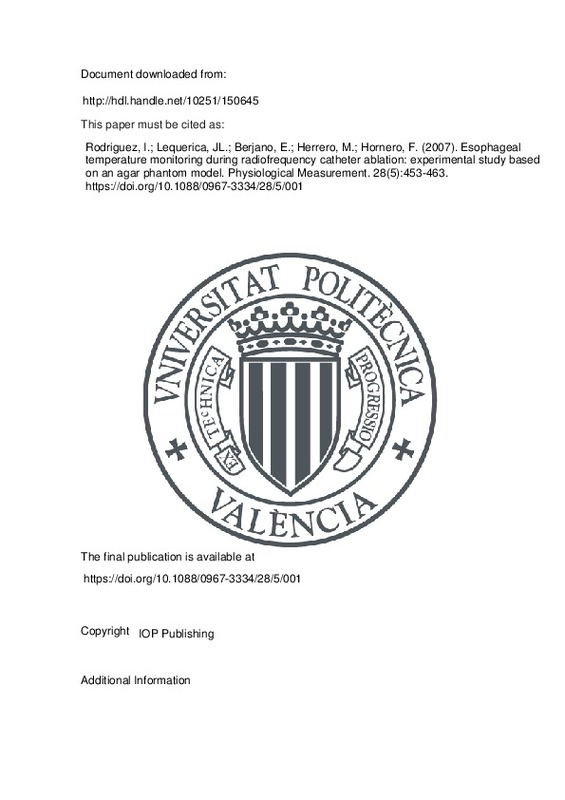Berjano, E. J., & Hornero, F. (2005). What affects esophageal injury during radiofrequency ablation of the left atrium? An engineering study based on finite-element analysis. Physiological Measurement, 26(5), 837-848. doi:10.1088/0967-3334/26/5/020
Hong Cao, Vorperian, V. R., Jang-Zem Tsai, Tungjitkusolmun, S., Eung Je Woo, & Webster, J. G. (2000). Temperature measurement within myocardium during in vitro RF catheter ablation. IEEE Transactions on Biomedical Engineering, 47(11), 1518-1524. doi:10.1109/10.880104
Cappato, R., Calkins, H., Chen, S.-A., Davies, W., Iesaka, Y., Kalman, J., … Skanes, A. (2005). Worldwide Survey on the Methods, Efficacy, and Safety of Catheter Ablation for Human Atrial Fibrillation. Circulation, 111(9), 1100-1105. doi:10.1161/01.cir.0000157153.30978.67
[+]
Berjano, E. J., & Hornero, F. (2005). What affects esophageal injury during radiofrequency ablation of the left atrium? An engineering study based on finite-element analysis. Physiological Measurement, 26(5), 837-848. doi:10.1088/0967-3334/26/5/020
Hong Cao, Vorperian, V. R., Jang-Zem Tsai, Tungjitkusolmun, S., Eung Je Woo, & Webster, J. G. (2000). Temperature measurement within myocardium during in vitro RF catheter ablation. IEEE Transactions on Biomedical Engineering, 47(11), 1518-1524. doi:10.1109/10.880104
Cappato, R., Calkins, H., Chen, S.-A., Davies, W., Iesaka, Y., Kalman, J., … Skanes, A. (2005). Worldwide Survey on the Methods, Efficacy, and Safety of Catheter Ablation for Human Atrial Fibrillation. Circulation, 111(9), 1100-1105. doi:10.1161/01.cir.0000157153.30978.67
Cummings, J. E., Schweikert, R. A., Saliba, W. I., Burkhardt, J. D., Brachmann, J., Gunther, J., … Natale, A. (2005). Assessment of Temperature, Proximity, and Course of the Esophagus During Radiofrequency Ablation Within the Left Atrium. Circulation, 112(4), 459-464. doi:10.1161/circulationaha.104.509612
D‘avila, A., Maldonado, P., Veronese, F., Mendonça, M. L. F., Colafranceschi, A. S., Colle, S., & Saad, E. B. (2005). Accuracy of esophageal temperature measurement and its correlation to microbubbles formation during catheter ablation of atrial fibrillation. Heart Rhythm, 2(5), S9. doi:10.1016/j.hrthm.2005.02.040
Doll, N., Borger, M. A., Fabricius, A., Stephan, S., Gummert, J., Mohr, F. W., … Hindricks, G. (2003). Esophageal perforation during left atrial radiofrequency ablation: Is the risk too high? The Journal of Thoracic and Cardiovascular Surgery, 125(4), 836-842. doi:10.1067/mtc.2003.165
Gillinov, A. M., Pettersson, G., & Rice, T. W. (2001). Esophageal injury during radiofrequency ablation for atrial fibrillation. The Journal of Thoracic and Cardiovascular Surgery, 122(6), 1239-1240. doi:10.1067/mtc.2001.118041
Goldberg, S. N., Ahmed, M., Gazelle, G. S., Kruskal, J. B., Huertas, J. C., Halpern, E. F., … Lenkinski, R. E. (2001). Radio-Frequency Thermal Ablation with NaCl Solution Injection: Effect of Electrical Conductivity on Tissue Heating and Coagulation—Phantom and Porcine Liver Study. Radiology, 219(1), 157-165. doi:10.1148/radiology.219.1.r01ap27157
YEN HO, S., SANCHEZ-QUINTANA, D., CABRERA, J. A., & ANDERSON, R. H. (1999). Anatomy of the Left Atrium:. Journal of Cardiovascular Electrophysiology, 10(11), 1525-1533. doi:10.1111/j.1540-8167.1999.tb00211.x
HORNERO, F., & BERJANO, E. J. (2006). Esophageal Temperature During Radiofrequency-Catheter Ablation of Left Atrium: A Three-Dimensional Computer Modeling Study. Journal of Cardiovascular Electrophysiology, 17(4), 405-410. doi:10.1111/j.1540-8167.2006.00404.x
Jain, M. K., & Wolf, P. D. (2000). In Vitro Temperature Map of Cardiac Ablation Demonstrates the Effect of Flow on Lesion Development. Annals of Biomedical Engineering, 28(9), 1066-1074. doi:10.1114/1.1310218
Kuwahara, T., Takahashi, A., Yokoyama, Y., Kobori, A., Sato, A., Iesaka, Y., … Aonuma, K. (2005). Importance of esophageal temperature monitoring for the avoidance of esophageal injury during circumferential left atrial ablation. Heart Rhythm, 2(5), S156. doi:10.1016/j.hrthm.2005.02.487
Lemola, K., Sneider, M., Desjardins, B., Case, I., Han, J., Good, E., … Oral, H. (2004). Computed Tomographic Analysis of the Anatomy of the Left Atrium and the Esophagus. Circulation, 110(24), 3655-3660. doi:10.1161/01.cir.0000149714.31471.fd
Lobo, S. M., Afzal, K. S., Ahmed, M., Kruskal, J. B., Lenkinski, R. E., & Goldberg, S. N. (2004). Radiofrequency Ablation: Modeling the Enhanced Temperature Response to Adjuvant NaCl Pretreatment. Radiology, 230(1), 175-182. doi:10.1148/radiol.2301021512
Meade, T., Razavi, M., Yang, D., Delapasse, S., Donsky, A., Ai, T., … Cheng, J. (2005). Real-time esophageal thermal profile during posterior left atrial radiofrequency ablation. Heart Rhythm, 2(5), S236. doi:10.1016/j.hrthm.2005.02.738
Pappone, C., Oral, H., Santinelli, V., Vicedomini, G., Lang, C. C., Manguso, F., … Morady, F. (2004). Atrio-Esophageal Fistula as a Complication of Percutaneous Transcatheter Ablation of Atrial Fibrillation. Circulation, 109(22), 2724-2726. doi:10.1161/01.cir.0000131866.44650.46
PERZANOWSKI, C., TEPLITSKY, L., HRANITZKY, P. M., & BAHNSON, T. D. (2006). Real-Time Monitoring of Luminal Esophageal Temperature During Left Atrial Radiofrequency Catheter Ablation for Atrial Fibrillation: Observations About Esophageal Heating During Ablation at the Pulmonary Vein Ostia and Posterior Left Atrium. Journal of Cardiovascular Electrophysiology, 17(2), 166-170. doi:10.1111/j.1540-8167.2005.00333.x
Piorkowski, C., Hindricks, G., Schreiber, D., Tanner, H., Weise, W., Koch, A., … Kottkamp, H. (2006). Electroanatomic reconstruction of the left atrium, pulmonary veins, and esophagus compared with the «true anatomy» on multislice computed tomography in patients undergoing catheter ablation of atrial fibrillation. Heart Rhythm, 3(3), 317-327. doi:10.1016/j.hrthm.2005.11.027
REDFEARN, D. P., TRIM, G. M., SKANES, A. C., PETRELLIS, B., KRAHN, A. D., YEE, R., & KLEIN, G. J. (2005). Esophageal Temperature Monitoring During Radiofrequency Ablation of Atrial Fibrillation. Journal of Cardiovascular Electrophysiology, 16(6), 589-593. doi:10.1111/j.1540-8167.2005.40825.x
Sánchez-Quintana, D., Cabrera, J. A., Climent, V., Farré, J., de Mendonça, M. C., & Ho, S. Y. (2005). Anatomic Relations Between the Esophagus and Left Atrium and Relevance for Ablation of Atrial Fibrillation. Circulation, 112(10), 1400-1405. doi:10.1161/circulationaha.105.551291
SCANAVACCA, M. I., D’ÁVILA, A., PARGA, J., & SOSA, E. (2004). Left Atrial-Esophageal Fistula Following Radiofrequency Catheter Ablation of Atrial Fibrillation. Journal of Cardiovascular Electrophysiology, 15(8), 960-962. doi:10.1046/j.1540-8167.2004.04083.x
Solazzo, S. A., Liu, Z., Lobo, S. M., Ahmed, M., Hines-Peralta, A. U., Lenkinski, R. E., & Goldberg, S. N. (2005). Radiofrequency Ablation: Importance of Background Tissue Electrical Conductivity—An Agar Phantom and Computer Modeling Study. Radiology, 236(2), 495-502. doi:10.1148/radiol.2362040965
Teplitsky, L., Perzanowski, C., Durrani, S., Berman, A. E., Hranitzky, P., & Bahnson, T. D. (2005). Radiofrequency catheter ablation for atrial fibrillation produces delayed and long lasting elevation of luminal esophageal temperature independent of lesion duration and power. Heart Rhythm, 2(5), S8-S9. doi:10.1016/j.hrthm.2005.02.038
Tsao, H.-M., Wu, M.-H., Higa, S., Lee, K.-T., Tai, C.-T., Hsu, N.-W., … Chen, S.-A. (2005). Anatomic Relationship of the Esophagus and Left Atrium. Chest, 128(4), 2581-2587. doi:10.1378/chest.128.4.2581
Wittkampf, F. H. M., Nakagawa, H., Yamanashi, W. S., Imai, S., & Jackman, W. M. (1996). Thermal Latency in Radiofrequency Ablation. Circulation, 93(6), 1083-1086. doi:10.1161/01.cir.93.6.1083
[-]







![[Cerrado]](/themes/UPV/images/candado.png)


